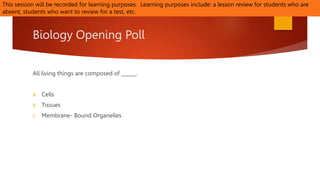
10.2 Cells.pptx
- 1. Biology Opening Poll All living things are composed of ______. A. Cells B. Tissues C. Membrane- Bound Organelles This session will be recorded for learning purposes. Learning purposes include: a lesson review for students who are absent, students who want to review for a test, etc.
- 2. Science Fact of the Day There are 37.2 trillion cells in your body 50,000 cells have died and been replaced while you read this science fact
- 3. Standards and Objectives B.1.5 Develop and use a model to illustrate the hierarchical organization of interacting systems (cell, tissue, organ, organ system) that provide specific functions within multicellular organisms. Students will be able to Compare and contrast organisms that are unicellular and multicellular. Compare and contrast prokaryotic cells and eukaryotic cells. Explain how cells were discovered and how the cell theory was developed.
- 4. Cells LESSONS 3.01, 3.02 AND 3.04
- 6. History of Cells First compound microscope was created in 1590 by Zacharias Janssen Robert Hooke discovered cells in 1665 Examined the bark of a cork tree using a compound microscope Anton van Leeuwenhoek observed first living cells in 1674 In 1838 Matthias Schleiden proposed all plants were made of cells In 1839 Theodor Schwann recognized that animals were made of cells In 1855 Rudolf Virchow declared that all living cells only come from other living cells
- 7. Modern Cell Theory All organisms are made of one or more cells. The cell is the basic unit of structure and function of living things. All cells come from other living cells. Cells contain genetic information that is passed on to the next generation of cells. Cells are chemically very similar. The flow of energy in living things occurs in cells.
- 8. Cell Characteristics Basic unit of structure and function of ALL living things Arise from existing cells Division or Union
- 9. Unicellular Unicellular Composed of a single cell All the characteristics of life happen within the cell Ex.) Bacteria
- 10. Multicellular Multicellular Composed of many cells Each type of cell performs a specific job (differentiated) Same basic internal structures Ex.) Humans
- 11. Prokaryotic Cells Cell that does NOT contain a nucleus or membrane bound organelles DNA usually exists as a looped molecule Earliest life- forms on earth Stromatolites – fossilized rock formations of prokaryotes dating back 3.5 billion years Cell Membrane DNA Cytoplasm Cell Wall
- 12. Eukaryotic Cells Cell contains a nucleus and other membrane bound organelles DNA is contained with the nucleus Can be unicellular or multicellular
- 13. Learning Check True or False Prokaryotic cells ALWAYS contain a nucleus
- 14. Unicellular Eukaryotes Some eukaryotes are single celled organisms Ex.) yeast, amoeba, paramecium, diatom
- 15. Example Classify the following organism An amoeba is a single celled organism that contains a nucleus and membrane bound organelles. Answer: Unicellular and eukaryotic Archaea is a domain of single celled organisms that do NOT contain a nucleus or membrane bound organelles.
- 16. Endosymbiotic Theory Eukaryotes arose from prokaryotes One prokaryotic cell may have engulfed another forming a union in which both cells worked cooperatively Mitochondria and chloroplasts contain their own DNA Organelle DNA share many traits with bacterial DNA
- 17. Assignment 10.2 Exit Ticket
Editor's Notes
- Leeuwenhoek called the living organisms he observed in pond water “wee beasties” Also observed bacteria, blood cells,, and yeast 1859 Louis Pasteur showed that spontaneous generation does not occur
- Proposed by Lynn Margulis